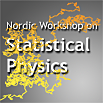Speaker
Zoran Konkoli
Description
The talk will discuss how Statistical Physics tools can be
used to understand biochemistry of the living cell.
Structures found in the living cell are rather special and
to achieve such task techniques used in the field of
Statistical Physics need to be slightly modified. A critical
reflection is needed on which techniques to use and for what
purpose. As an example the theory of diffusion controlled
reactions will be reviewed with a purpose of using it for
understanding spatio-temporal organization of the living cell.
It will be argued that formalism of diffusion controlled
reactions is a suitable framework for describing living cell
and the scope and the limitations of such approach will be
discussed. Informal discussion will be given around problems
(and possible traps) one meets when trying to compute
properties of biochemical reactions in the cell interior.
For example, mean field calculations are routinely used to
model cell biochemistry and there usage is rarely
questioned. The validity of mean field equations will be
critically reviewed. Some situations when these equations do
not work will be mentioned (low dimension, fluctuation
dominated kinetics).
The generic features of spatio temporal organization of the
living cell biochemistry will be discussed with particular
emphasis on geometrical (spatial) features, ranging from
shape of reactants towards spatial organization of
intracellular reaction volumes. There is a great need for
developing analysis tools that could help us understand
intracellular organization and geometry and it will be
argued that the theory of diffusion controlled reactions can
be useful in the context. As an example, the brief overview
of Geometry-Reaction InterPlay framework (GRIP) will be given.
KEYWORDS: fluctuation dominated kinetics, diffusion
controlled reactions, reaction-geometry interplay, reactions
in restricted geometries, shape of reactants, shape of
reaction volume, topology of pathway graph

